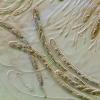
02-01-2026 17:43
MARICEL PATINOHi there, although I couldn't see the fruitbody, I

01-01-2026 18:35
Original loamy soil aside a artificial lake.The co

31-12-2025 19:27
Collected from loamy soil, at waterside (completel

30-12-2025 16:44
Pascal DucosBonjour,Une anamorphe rose stipitée, très nombre

30-12-2025 17:14
 Bernard CLESSE
Bernard CLESSE
Bonjour à toutes et tous,Pourriez-vous aider Albe
Photo Ascocoryne cylichnium
Roland Labbé,
29-10-2008 17:15
Apothécie discoïde ou turbinée, gélatineuse, glabre, pourprée
Spores étroitement ellipsoïdes, lisses, multiseptées à maturité, hyalines, 21-31 x 4,5-6 µm, 24,1 x 5,2 en moyenne (30 spores), Q = 4,63
Asques à 8 spores bisériées, avec pore amyloïde en Melze
Paraphyses filiformes, renflées et parfois courbes à l’apex
Excipulum ectal en textura globulosa
Poussant sur bois pourri
Hans-Otto Baral,
29-10-2008 17:17

Re:Photo Ascocoryne cylichnium
Sounds like A. cylichnium. Again I see no photo or document.
Zotto
Zotto
Roland Labbé,
29-10-2008 17:18
Re:Photo Ascocoryne cylichnium
Voilà, c'est réussi ! à vous Zotto
Roland
Roland
Hans-Otto Baral,
29-10-2008 21:13

Re:Photo Ascocoryne cylichnium
o.k, seems to be good images but could you make it 3x as large? I can only see the apos but nothing of the micros. perhaps you must make three parts of it. The micros need at least 4x increase in size.
Zotto
Zotto
Christian Lechat,
29-10-2008 22:06

Re:Photo Ascocoryne cylichnium
Roland,
could you please to send me your original image? I will post it here.
Thank you :)
could you please to send me your original image? I will post it here.
Thank you :)
Roland Labbé,
30-10-2008 00:43
Re:Photo Ascocoryne cylichnium
Christian,
Trois photos vous sont expédiées à 1000 pixels chacune.
Je crois qu'elles devraient être satisfaisantes pour Mr. Zotto.
Roland
Trois photos vous sont expédiées à 1000 pixels chacune.
Je crois qu'elles devraient être satisfaisantes pour Mr. Zotto.
Roland
Christian Lechat,
30-10-2008 06:23
Hans-Otto Baral,
30-10-2008 08:47

Re:Photo Ascocoryne cylichnium
Hi Roland and Christian
thanks for the enlargement. Some comments:
-Spore size and number of sept clearly point to cylichnium, also the little inflated paraphyses (A. inflata has capitate paraphyses).
-iodine reaction is surprisingly very faint. Even in Melzer it should be much stronger. If you have Lugol please test that, it should be used as standard in Ascos instead of Melzer. Also cou can try a KOH-mount to which you add ample Melzer. KOH enhances the blue reaction.
- I see you use physiological NaCl solution. This makes of course no sence in the case of dead material. But even with living you will se no difference between that and normal tap water.
- The oil drops in the spores are fused to large drops. If this is really cylichnium, the mature aseptate spores should have been multiguttulate. This original guttule pattern is sometimes even seen in very old dead herbarium material, especially in spores still inside asci. In contrast, sarcoides and inflata have two large among the many small oil drops.
Zotto
thanks for the enlargement. Some comments:
-Spore size and number of sept clearly point to cylichnium, also the little inflated paraphyses (A. inflata has capitate paraphyses).
-iodine reaction is surprisingly very faint. Even in Melzer it should be much stronger. If you have Lugol please test that, it should be used as standard in Ascos instead of Melzer. Also cou can try a KOH-mount to which you add ample Melzer. KOH enhances the blue reaction.
- I see you use physiological NaCl solution. This makes of course no sence in the case of dead material. But even with living you will se no difference between that and normal tap water.
- The oil drops in the spores are fused to large drops. If this is really cylichnium, the mature aseptate spores should have been multiguttulate. This original guttule pattern is sometimes even seen in very old dead herbarium material, especially in spores still inside asci. In contrast, sarcoides and inflata have two large among the many small oil drops.
Zotto
Roland Labbé,
30-10-2008 19:26
Re:Photo Ascocoryne cylichnium
Hi Zotto !
I wiil use Lugol insted Melzer, with a KOH mount now.
The specimens have been studied when dry and the two guttules seen at each end of the spores observed only some days after collection.
Roland
I wiil use Lugol insted Melzer, with a KOH mount now.
The specimens have been studied when dry and the two guttules seen at each end of the spores observed only some days after collection.
Roland
Hans-Otto Baral,
30-10-2008 21:54

Re:Photo Ascocoryne cylichnium
Hi Roland
It is well possible that the process of drying may already induce fusion of small oil drops to large even if no heat is applied and the spores remain alive thereby. Ascocoryne does not dry down under natural conditions, I think the gelatinous flesh is able to keep enough water over a shorter dry period.
Zotto
It is well possible that the process of drying may already induce fusion of small oil drops to large even if no heat is applied and the spores remain alive thereby. Ascocoryne does not dry down under natural conditions, I think the gelatinous flesh is able to keep enough water over a shorter dry period.
Zotto
Hans-Otto Baral,
31-10-2008 22:51

Re:Photo Ascocoryne cylichnium
Looks live and multiguttulate, but the resolution is a bit too small to see the details. Should be cylichnium.
Zotto
Zotto




 5629.pdf
5629.pdf